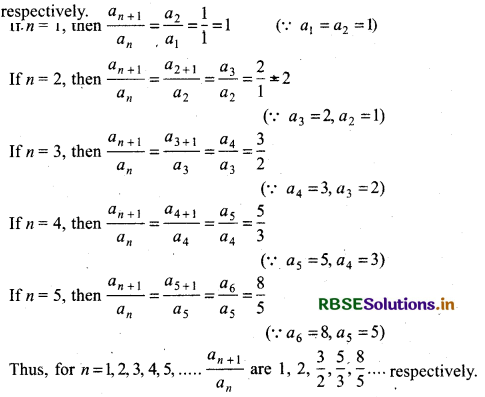RBSE Solutions for Class 11 Maths Chapter 9 Sequences and Series Ex 9.1
Rajasthan Board RBSE Solutions for Class 11 Maths Chapter 9 Sequences and Series Ex 9.1 Textbook Exercise Questions and Answers.
RBSE Class 11 Maths Solutions Chapter 9 Sequences and Series Ex 9.1
Write the first five terms of each of the sequences in exercises 1 to 6 whose nth terms are:
Question 1.
an = n(n + 2)
Answer:
Putting n = 1, 2, 3, 4, 5
a1 = 1 × (1 + 2) = 3
a2 = 2 × (2 + 2) = 8
a3 = 3 × (3 + 2) = 15
a4 = 4 × (4 + 2) = 24
a5 = 5 × (5 + 2) = 35
Thus, first five terms of the sequence are 3, 8, 15, 24, 35.

Question 2.
an = \(\frac{n}{n+1}\)
Answer:
Putting n = 1, 2, 3, 4, 5
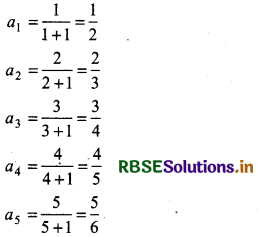
Thus, first five terms of the sequence are \(\frac{1}{2}, \frac{2}{3}, \frac{3}{4}, \frac{4}{5}, \frac{5}{6}\)
Question 3.
an = 2n
Answer:
Putting n = 1, 2, 3, 4, 5
a1 = 21 = 2
a2 = 22 = 4
a3 = 23 = 8
a4 = 24 = 16
a5 = 25 = 32
Thus, first five terms of the sequence are 2, 4, 8, 16, 32
Question 4.
an = \(\frac{2 n-3}{6}\)
Answer:
Putting n = 1, 2, 3, 4, 5
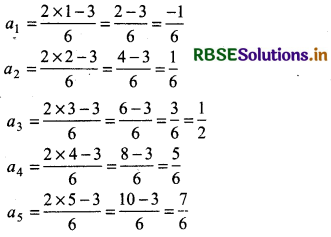
Thus, first five terms of the sequence are \(\frac{-1}{6}, \frac{1}{6}, \frac{1}{2}, \frac{5}{6}, \frac{7}{6}\).

Question 5.
an = (- 1)n - 1 5n + 1
Answer:
Putting n = 1, 2, 3, 4, 5
a1 = (- 1)1 - 1 51 + 1
= (- 1)0 52 = 25
a2 = (- 1)2 52 + 1
= (- 1)1 53 = - 125
a3 = (- 1)3 - 1 53 + 1
= (- 1)2 54 = 625
a4 = (- 1)4 - 1 54 + 1
= (- 1)3 55 = - 3125
a5 = (- 1)5 - 1 55 + 1
= (- 1)4 56 = 15625
Thus, first five terms of the sequence are 25, - 125, 625, - 3125, 15625
Question 6.
an = n\(\frac{n^2+5}{4}\)
Answer:
Putting n = 1, 2, 3, 4, 5
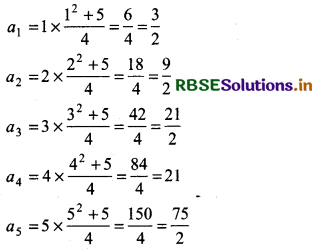
Thus, five terms of the sequence are \(\frac{3}{2}, \frac{9}{2}, \frac{21}{2}, 21, \frac{75}{2}\)

Find the indicated terms in each of the sequences in exercise 7 to 10 whose nth term are:
Question 7.
an = 4n - 3;a17, a24
Answer:
nth term of given the sequence an = 4n - 3
Putting n = 17 and n = 24 in an = 4n - 3
a17 = 4 × 17 - 3
= 68 - 3
= 65
and a24 = 4 × 24 - 3
= 96 - 3
= 93
Thus, a17 = 65 and a24 = 93
Question 8.
an = \(\frac{n^2}{2^n}\); a7
Answer:
nth term of the given sequence an = \(\frac{n^2}{2^n}\)
Putting n = 7, we get
a7 = \(\frac{7^2}{2^7}\) = \(\frac{49}{128}\)
Thus, the required term a7 = \(\frac{49}{128}\)
Question 9.
a = (- 1)n - 1 n3; a9
Answer:
nth term of the given sequence
an = (- 1)n - 1 n3
Putting n = 9, we get
a = (- 1)9 - 1 93
= (- 1)8 93 = 729
Thus, required term a9 = 729
Question 10.
an = \(\frac{n(n-2)}{n+3}\); a20
Answer:
nth term of the given sequence
an = \(\frac{n(n-2)}{n+3}\)
Putting n = 20, we get
a20 = \(\frac{20(20-2)}{20+3}=\frac{20 \times 18}{23}=\frac{360}{23}\)
Thus, the required term a20 = \(\frac{360}{23}\)

Write the first five terms of each of the sequences in exercise 11 to 13 and obtain the corresponding series.
Question 11.
a1 = 3, an = 3an - 1 + 2, for all n > 1.
Answer:
Putting n = 2, 3, 4, 5 in an = 3an - 1 + 2
a2 = 3a2 - 1 + 2
= 3a1 + 2
= 3 × 3+ 2 (∵ a1 = 3)
= 11
a3 = 3 × a3 - 1 + 2
= 3a2 + 2
= 3 × 11 + 2 (∵ a2 = 11)
= 35
a4 = 3a4 - 1 + 2
= 3 × a3 + 2
= 3 × 35 + 2 (∵ a3 = 35)
105 + 2 = 107
a5 = 3 × a5 - 1 + 2
= 3 × a4 + 2
= 3 × 107 + 2 (∵ a4 = 107)
= 321 + 2 = 323
Thus, five terms of sequence are 3, 11, 35, 107, 323 and corresponding series is 3 + 11 + 35 + 107 + 323....
Question 12.
a1 = - 1, an = \(\frac{a_{n-1}}{n}\), where n ≥ 2
Answer:
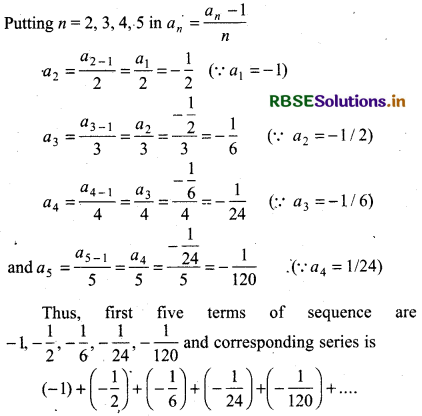

Question 13.
a1 = a2 = 2, an = an - 1 - 1, n > 2
Answer:
Given a1 = a2 = 2, an = an - 1 - 1
Here, first term a1 = second term a2 = 2
Putting n = 3, 4, 5 in an = an - 1
a3 = a3 - 1 - 1
= a2 - 1
∴ a3 = 2 - 1 = 1 (∵ a2 = 2)
a4 = a4 - 1
= 1 - 1 (∵ a3 = 1)
= 0
a5 = a5 - 1 - 1
= a4 - 1 .
= 0 - 1 [∵ a4 = 0]
= - 1
Thus, five terms of sequence are 2, 2, 1, 0, - 1 and corresponding series is 2 + 2 + 1 + 0 + (- 1) + ..................
Question 14.
The Fibonacci sequence is defined by:
1 = a1 = a2 and an = an - 1 + an - 2, n > 2 find \(\frac{a_{n+1}}{a_n}\) for n = 1, 2, 3, 4, 5, ..............
Answer:
Given: 1 = a1 = a2 and an = an - 1 + an - 2
(Fibonacci sequence)
For n = 3, 4, 5, 6
nth term an = an - 1 + an - 2
Putting n = 3, we get
a3 = a3 - 1 + a3 - 2
= a2 + a1
= 1 + 1 (∵ a1 = a2 = 1)
= 2
Putting n = 4, we get
a4 = a4 - 1 + a4 - 2
= a3 + a2
= 2 + 1 (∵ a3 = 2, a2 = 1)
= 3
Putting n = 5, we get
a5 = a5 - 1 + a5 - 2
= a4 + a3
= 3 + 2 (∵ a4 = 3, a3 = 2)
= 5
And Putting n = 6, we get
a6 = a6 - 1 + a6 - 2
= a5 + a4
= 5 + 3 (∵ a5 = 5, a4 = 3)
= 8
Now,
